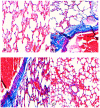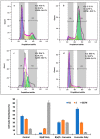Curcumin, an Active Constituent of Turmeric Spice: Implication in the Prevention of Lung Injury Induced by Benzo(a) Pyrene (BaP) in Rats
- PMID: 32046055
- PMCID: PMC7037262
- DOI: 10.3390/molecules25030724
Curcumin, an Active Constituent of Turmeric Spice: Implication in the Prevention of Lung Injury Induced by Benzo(a) Pyrene (BaP) in Rats
Abstract
Benzo(a)pyrene (BaP) is a well-known carcinogen and enhances oxidative stress and apoptosis and also alters several molecular pathways. Curcumin is an active ingredient of Curcuma longa, and it has potent anti-inflammatory, antioxidant activity that defends cells from oxidative stress and cell death. The objectives of the present study were to explore the protective effects of curcumin against long-term administration of BaP induced disturbances in lungs of rats. Male rats were randomly divided into four groups: saline control, BaP only, BaP + curcumin, and curcumin only. Lung histopathology, electron microscopy, inflammatory cytokine release, antioxidant levels, apoptosis, and cell cycle were examined. Instillation of BaP significantly increased infiltration of inflammatory cells in alveolar space and inflammatory cytokine in blood. BaP induced lung tissue alterations including mild bronchitis, scant chronic inflammatory cell infiltrate in the wall of the respiratory bronchiole, and mild intra-alveolar haemorrhage. However, these alterations were found to be significantly less as mild inflammatory cell infiltrate in curcumin plus BaP treated group. Furthermore, electron microscopy results also showed necrotic changes and broken cell membrane of Type-II epithelial cell of alveoli in BaP group, which was reduced after adding curcumin treatment. In addition, we found BaP plus curcumin treatment effectively reduced inflammatory cytokines Tumour Necrosis Factor alpha (TNF-α), Interleukin 6 (IL-6), and C-reactive protein (CRP) levels in blood serum. Moreover, the levels of tunnel staining and p53 expression were significantly increased by BaP, whereas these changes were noticeably modulated after curcumin treatment. BaP also interferes in normal cell cycle, which was significantly improved with curcumin treatment. Overall, our findings suggest that curcumin attenuates BaP -induced lung injury, probably through inhibiting inflammation, oxidative stress and apoptosis in lung epithelial cells, and improving cell proliferation and antioxidants level. Thus, curcumin may be an alternative therapy for improving the outcomes of Benzo(a)pyrene-induced lung injury.
Keywords: antioxidant; apoptosis; benzo(a)pyrene; inflammation; lung injury.
Conflict of interest statement
The authors declare no conflict of interest.
Figures










References
-
- Staniszewska M., Graca B., Bełdowska M., Saniewska D. Factors controlling benzo(a)pyrene concentration in aerosols in the urbanized coastal zone. A case study: Gdynia, Poland (Southern Baltic Sea) Environ. Sci. Pollut. Res. Int. 2013;20:4154–4163. doi: 10.1007/s11356-012-1315-0. - DOI - PMC - PubMed
-
- Jiang J., Xu H., Wang H., Zhang Y., Ya P., Yang C., Li F. Protective effects of lemongrass essential oil against benzo(a)pyrene-induced oxidative stress and DNA damage in human embryonic lung fibroblast cells. Toxicol. Mech. Methods. 2017;27:121–127. doi: 10.1080/15376516.2016.1266541. - DOI - PubMed
MeSH terms
Substances
LinkOut - more resources
Full Text Sources
Research Materials
Miscellaneous

